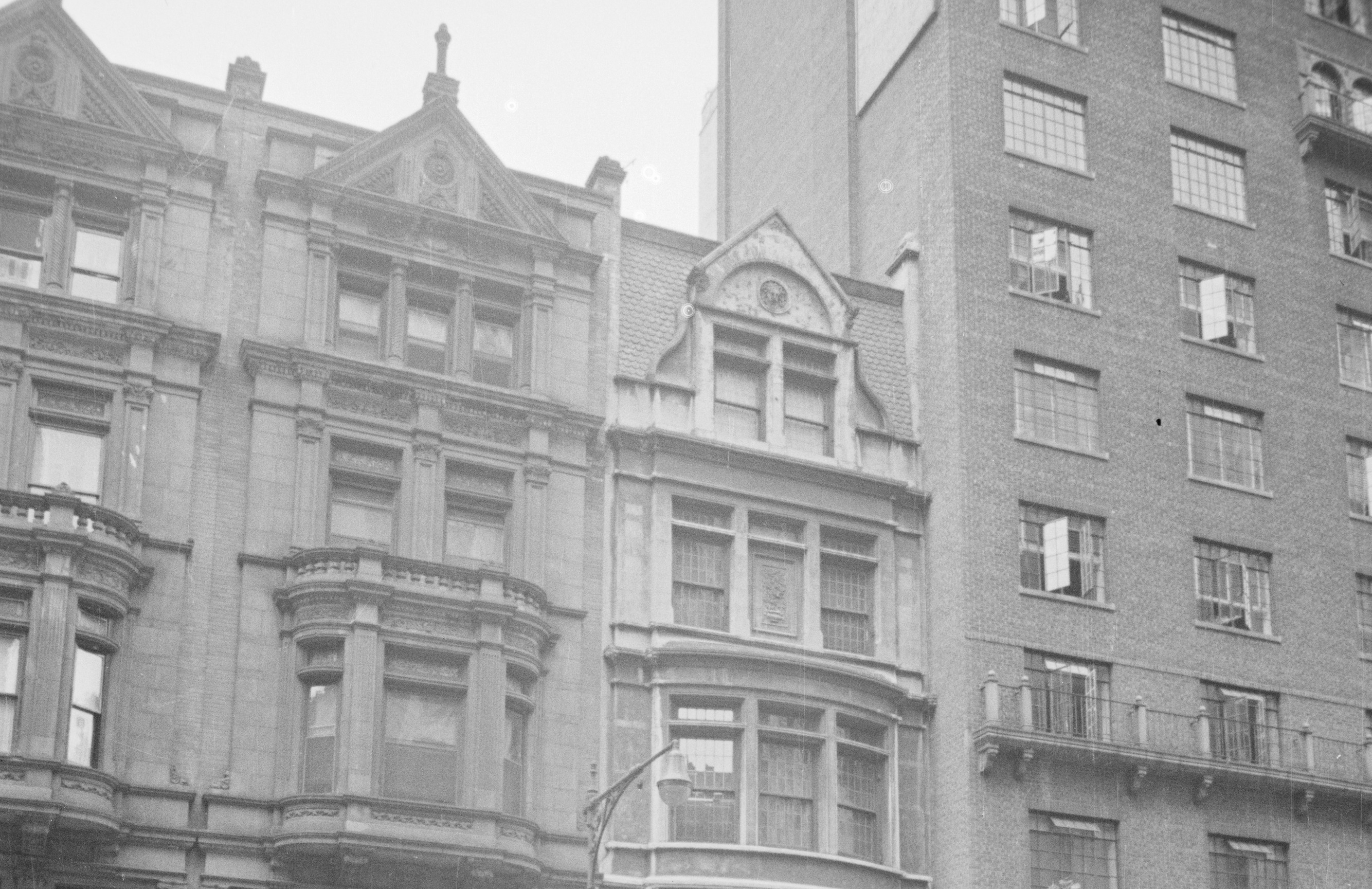
123 West 86th Street
by Tom Miller
The land around the corner of Columbus Avenue and 86th Street was once the country estate of the wealthy Livingston family. By the mid-1880s when streets and avenues crisscrossed the property, it was owned by T. E. D. Powers who partnered with developer and architect John G. Prague to develop the plots. The pair would build more than 230 residences in rapid-fire succession. The Real Estate Record and Guide said in 1890, “They have created a neighborhood.”
Prague developed some of the plots on his own. Such was the case in 1887 when he designed and built six row houses on West 86th Street between Columbus and Amsterdam Avenues. Their designs were trademark John G. Prague–Northern Renaissance Revival splashed with touches of Queen Anne. Four stories tall above English basements and 20-feet-wide, the residences were intended for well-to-do families.
Among them was 123 West 86th Street. Prague placed a full-width oriel at the second floor. The fourth floor took the shape of a steep, fish-scale shingled mansard fronted by a Northern Renaissance inspired dormer. It was decorated with a centered portrait rondel flanked by two carved faces that gazed east and west.
Prague sold the newly completed house to Thorton N. Motley, who immediately leased it to attorney William Mills Ivins. Born in 1851, he and his wife, the former Emma Laura Yard, had five children: Margaret, Eleanor Laura, William Jr., James Sterling Yard, and Katherine.
He fought tirelessly against election fraud and became president of the Executive Committee of the Electoral Laws Improvement Association.
Shortly after the family moved in, on June 22, 1890 the New York Herald printed a sketch of the house and wrote:
Mr. Ivins house is a four story and basement brown stone, the upper portion being finished in brick. A fanciful gable, with a sculptured head in the middle, juts into the high roof. The entire second story front swings outward into one large bay window.
Wealth and good taste are apparent in all the interior furnishings and decorations. The prevailing tone in the parlors is a dark red or purple. By drawing back the wide doors or portieres all, the rooms on the parlor floor can be thrown into one.
Ivins (who was known to friends as Will) was a member of the law firm Ivins, Kidder & Melcher, and was one of Manhattan’s most visible reformers. The New York Herald said his “greatest pleasure in life apparently is to twist the tail of the Tammany tiger or take the scalp of the Tammany brave.” He fought tirelessly against election fraud and became president of the Executive Committee of the Electoral Laws Improvement Association. He was, as well, a member of the Ballot Reform Committee of Citizens Union, the Honest Ballot Association, and the City Reform Club. The year he and his family moved into 123 West 86th Street, he published Machine Politics and Money in Elections in New York City.
On June 16, 1897, The Sun ran the shocking headline, “Wm. M. Ivins Arrested.” The evening before, at around 8:45, he had headed home. At 40th Street and Broadway he let several street cars pass because they were overcrowded. Finally, said the article, “Seeing that there was no hope of getting a seat, Mr. Ivins at last jumped on the front platform of a closed car…There were other persons on the platform, and the car was crowded with men and women, the back platform being so jammed that the people had difficulty getting off.”
At 50th Street, “a crowd of men and women with transfers” made the packed conditions worse. Then, recounted The Sun, “At the Fifty-ninth street transfer station a number of people left the car, and the inside became less like the interior of a sardine box.” The grip man (the worker who operated the “grip” that started and stopped the car) ordered Ivins to move inside the car. A legal debate ensued.
Ivins refused to enter the packed car and the grip man refused to move it. Ivins “told the grip man that the car was crowded when he got on; that it was crowded then, and that, as his fare had been accepted when he was standing on the platform, he intended to stay there, holding that the company had entered into a contract to take him uptown on that part of the car where his fare was collected.”
The grip man summoned the conductor, named Riede, who explained that riding on the platform was a violation of company rules. Ivins refused to budge. Riede directed “that he must go inside the car or get off unless he wished to be arrested,” said the article.
“I shall be arrested then,” said Ivins.
In the meantime, the incident had brought six other streetcars to a halt behind it. Policeman Dobbins came to see what the problem was, and was told by Riede about Ivins’s obstinacy. Ivins was arrested.
It was now Riede who was in an uncomfortable position. He was expected to follow Dobbins and his prisoner to the 86th Street station house to make a complaint. But he had to run the streetcar. He chose the latter. The Sun reported, “Mr. Ivins was detained for a few minutes and, as Riede failed to appear, he was allowed to continue on his way home.”
Emma Yard Ivins was an amateur photographer. Her sympathies were with the suffragist movement, but peer pressure kept her from being an activist, at least for now. That changed in January 1900. In a letter to Susan B. Anthony, she explained in part:
For a long time I have had a great desire to enroll myself on the side of the suffragists. My sympathies have always been with you, but the “drip,” as the college boys calls it, of my dearest friends, who, alas, are among the anti-suffragists, has more and more convinced me that silent sympathy is neither sufficient nor decent.
Emma Ivins would become a lifetime member of the National American Woman Suffrage Association, the treasurer of the New York State Woman Suffrage Association, and a delegate to the International Congress of Women.
William Mills Ivins Jr. would go on to become the curator of the department of prints at the Metropolitan Museum of Art from its inception in 1916 until 1946.
Her sympathies were with the suffragist movement, but peer pressure kept her from being an activist, at least for now.
The Ivins family left 123 West 86th Street in 1900, prompting the Real Estate Record & Guide to report its sale on March 10. Thorton N. Motley fired off a heated letter that said in part, “There has been no sale of this property since it was purchased originally in 1888. The house has never been for sale.”
The Motley family had, indeed, not sold the property, but had moved into 123 West 86th Street. Motley was the head of Thorton N. Motley & Co., sellers of “railway, steamship, machinists’ and contractors’ tools and supplies,” and a director in the Manhattan Oil Co. He and his wife, the former Kathryn Kennard, had three children.
Kathryn Motley was looking to replace a servant later that year. An advertisement in The New York Times on November 11, 1900 read, “Wanted–Competent waitress and chambermaid; must be willing and obliging, and have best reference from last employer.”
The family’s residency would be short lived. Motley sold the house in December 1904 to Samuel D. Styles, who resold it by 1908 to Henry Edward Oppenheimer and his wife, the former Mella Flesher. The couple had four children, Julie Adelaide, Matilda, Henry Jr., and Edward Davidson.
On January 26, 1913, The New York Times announced, “Mr. and Mrs. Henry E. Oppenheimer of 123 West Eighty-sixth Street will celebrate their twenty-fifth wedding anniversary on Saturday.” Sadly, it would be one of their last. Mella died on January 10, 1916.
By the time Henry Edward Oppenheimer, Jr. graduated from the Stevens Institute of Technology with an engineering degree in 1919, his father had married Lena Davidson.
It appears that Lena’s bachelor brother, Herman, moved into the house, as well. The 54 year old died on March 1, 1921, and his funeral was held in the parlor two days later.
Shortly afterward, Oppenheimer sold 123 West 86th Street to Dr. Harry Finkelstein. He hired architect M. Joseph Harrison to convert the basement level to his doctor’s office. Harrison removed the stoop and lowered the doorway to just below grade. Harrison filled the tympana of the arched openings at this level with attractive carved fans. The parlor windows and former entrance were replaced with a handsome grouping of small-paned windows.
Born in New York City in 1883, Finkelstein was a specialist in orthopedic surgery. One of 16 children of Jewish immigrants from Belarus, he had graduated from Columbia University’s Medical School in 1904. He was connected with the orthopedic departments of Mount Sinai and Beth Israel Hospitals. In 1924 he became a chief of Orthopedic Services of the Hospital for Joint Diseases.
Dr. Harry Finkelstein died in 1939, the year after his daughter Rita was married to Dr. H. L. Jacobius. It appears that Jacobius may have utilized his father-in-law’s medical office for a while, for it was not until 1945 that an advertisement appeared in New York Medicine offering, “Beautifully furnished, complete laboratory, radiography and physiotherapy, 24-hour telephone. Secretarial and nurse’s service. Any hours day or night to any specialist.”
Rudolph Muller purchased 123 West 86th Street that year. By now the other houses in the neighborhood had been converted to business and rooming houses, or demolished for commercial and apartment buildings. And it did not take Muller long to join the trend. A renovation completed in 1946 resulted in doctor’s offices in the basement level, as had been the case since 1921, and two apartments each on the upper floors.
The configuration lasted until a slight remodeling in 1998 converted the second floor to a single apartment. The former Ivins house is one of four of the John G. Prague’s original six to survive. Although they are all altered, they give us a glimpse into what West 86th Street looked like in its more genteel days of the 1880s.
Tom Miller is a social historian and blogger at daytoninmanhattan.blogspot.com


